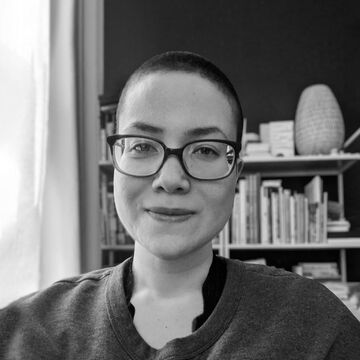| Design Strategies |
Visual Communication Design |
2900 (086) |
Spring 2024 |
|
Description
What are the concerns that drive one's creative practice? How does one set the terms for its future development? Sophomore Seminar offers strategies for students to explore, reflect upon, and connect common themes and interests in the development of an emerging creative practice that will serve as the basis of their ongoing studies at SAIC and beyond. Students will examine historical and contemporary influences and contextualize their work in relation to the diverse art-worlds of the 21st Century. Readings, screenings, and field trips will vary each semester. Presentations by visiting artists and guest speakers will provide the opportunity for students to hear unique perspectives on sustaining a creative practice. One-on-one meetings with faculty will provide students with individualized mentorship throughout the semester. During interdisciplinary critiques, students will explore a variety of formats and tools to analyze work and provide peer feedback. The class mid-term project asks students to imagine a plan for their creative life and devise a self-directed course of study for their time at school. The course concludes with an assignment asking students to develop and document a project or body of work demonstrating how the interplay of ideas, technical skills, and formal concerns evolve through iteration, experimentation and revision. Prerequisite: Must be a sophomore to enroll.
|
Class Number
2252
Credits
3
|
| Design Strategies |
Visual Communication Design |
2900 (087) |
Spring 2024 |
|
Description
What are the concerns that drive one's creative practice? How does one set the terms for its future development? Sophomore Seminar offers strategies for students to explore, reflect upon, and connect common themes and interests in the development of an emerging creative practice that will serve as the basis of their ongoing studies at SAIC and beyond. Students will examine historical and contemporary influences and contextualize their work in relation to the diverse art-worlds of the 21st Century. Readings, screenings, and field trips will vary each semester. Presentations by visiting artists and guest speakers will provide the opportunity for students to hear unique perspectives on sustaining a creative practice. One-on-one meetings with faculty will provide students with individualized mentorship throughout the semester. During interdisciplinary critiques, students will explore a variety of formats and tools to analyze work and provide peer feedback. The class mid-term project asks students to imagine a plan for their creative life and devise a self-directed course of study for their time at school. The course concludes with an assignment asking students to develop and document a project or body of work demonstrating how the interplay of ideas, technical skills, and formal concerns evolve through iteration, experimentation and revision. Prerequisite: Must be a sophomore to enroll.
|
Class Number
2253
Credits
3
|
| Truth, Perception and Story-Telling in Artists' Books |
Visual Communication Design |
3191 (001) |
Spring 2024 |
|
Description
Stories are a fundamental way that we share and understand information to make meaning. Storytelling, then, is in part an investigation of ?truths??of various realities that shape how we see the world. The intersection of content, internal narrative structure, and physical form, storytelling can illuminate ?truths? in ways that cause us to more deeply examine our perceptions, ideas, and beliefs. This course focuses on notions of truth in expression: how a fictional approach can express emotional truths; how multiple and contradictory views of a situation can reveal a truth; and how perceptions and beliefs can be called into question through story construction. A selection of readings and works, as well as visits to the Joan Flasch Artists' Book Collection, will provide examples of traditional vs. nontraditional, linear vs. nonlinear, and fiction vs. nonfiction narratives. Together with exercises in paper-based forms, they are starting points for exploring physical structures, methods, and devices of narrative discourse. The course treats the book form in broad terms: sequencing that reveals content or meaning over time. In 3-4 projects, students will develop their own content, work within project parameters to construct stories through image and/or text, and experiment with possibilities in narrative structure and form, whether paper-based or in other media.
|
Class Number
1977
Credits
3
|
| Beyond the Margins: Self-Publishing in Practice |
Visual Communication Design |
3300 (001) |
Fall 2024 |
|
Description
This studio course surveys cross-disciplinary approaches to publishing, encouraging students to explore the role of publications in their creative practices. Self-publishing and independent publishing models will be studied as ways to express ideas, share stories, and form community. The course will cover periodical, serial, and standalone formats, such as journals, chapbooks, and zines; varied design and production methods, including DIY, bookbinding, and printing techniques; and distribution platforms and strategies, including book/zine fairs. Readings will include publishing manifestos and projects by artists, designers, writers, and small presses, as well as visits to the Joan Flasch Artists' Book Collection. Students will produce 2-3 self-directed, editioned projects that could serve as foundations for or further developments of their publishing practices. Pre-req: Viscom 3011 Intermediate Type or Viscom 3001 Intermediate Graphic Design, or instructor consent.
|
Class Number
2108
Credits
3
|
| Guided Study |
Masters in Fine Arts Low Residency |
6907 (002) |
Summer 2024 |
|
Description
Guided Studies are intensive, self-driven courses of study that have a clear rationale for their configuration and articulate an expressed need in terms of a student's scholarly, material, and theoretical research. As a 3 credit course, a Guided Study constitutes 135 hours of study and production on the part of the student, including four meetings (virtual or otherwise) with a supervising faculty who has expertise in the research areas. On the Guided Study syllabus co-produced by the LRMFA student and supervising faculty, expected research accomplishments must be formulated, alongside a course description, learning objectives, evaluation criteria, a proposed timeline, a communication plan, and a suggested reading list or bibliography. Open to Low Residency MFA students only.
|
Class Number
1414
Credits
3
|

